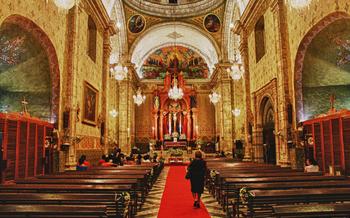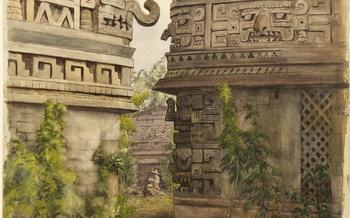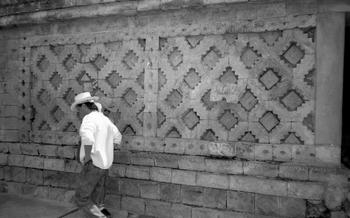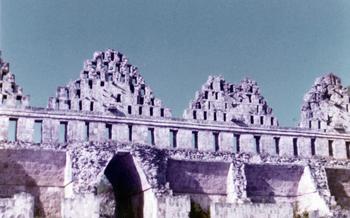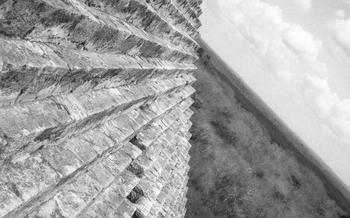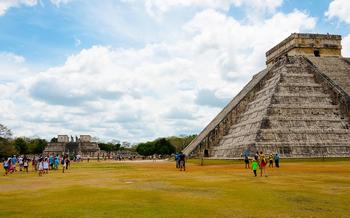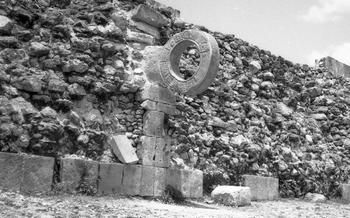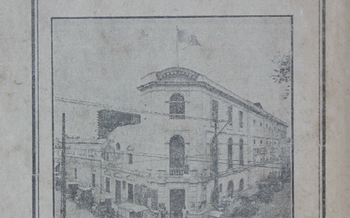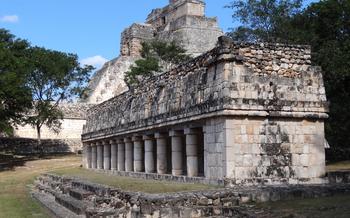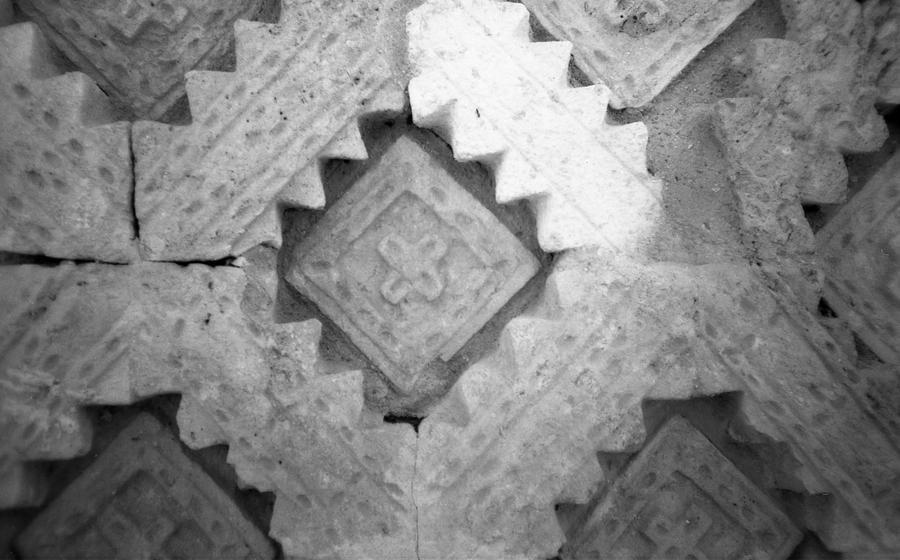
Merida's Cathedral
- Uxmal, a Majestic City in the Yucatan Peninsula
- Merida's Cathedral, a Symbol of Faith and Heritage
- Exploring the Grand Plaza of Uxmal
- Witnessing the Magic of the Light and Sound Show
- Discovering the Secrets of the Governor's Palace
- Conquering the Great Pyramid of Uxmal
- Unveiling the Mysteries of the Nunnery Quadrangle
- Appreciating the Art of Stone Carvings at Uxmal
- Strolling Through the Historic Center of Merida
- Visiting the Merida Cathedral, a Masterpiece of Colonial Architecture
- Exploring the Regional Cuisine of Merida
- Discovering the Mayan World Museum of Merida
- Unveiling the Secrets of the Cenotes near Merida
- Experiencing the Vibrant Culture of Merida
- Insider Tip: Planning Your Visit to Uxmal and Merida
Uxmal, a Majestic City in the Yucatan Peninsula
Uxmal, a once-thriving Mayan city-state, stands as a testament to the architectural prowess and cultural legacy of the ancient Maya civilization. Located in the heart of the Yucatan Peninsula, this awe-inspiring city is approximately 62 miles (100 kilometers) south of Merida, the capital of Yucatan. Uxmal's unique architectural style sets it apart from other Mayan cities, characterized by its intricate stone carvings, corbelled arches, and elaborate facades adorned with mythical creatures and geometric patterns. Recognized for its exceptional cultural significance, Uxmal has been designated as a UNESCO World Heritage Site, attracting visitors from around the world who seek to delve into the mysteries of this ancient metropolis.
Merida's Cathedral, a Symbol of Faith and Heritage
During the Spanish colonial era, Merida emerged as a prominent city in the Yucatan Peninsula. Amidst the transformation of the region, the construction of Merida's Cathedral commenced, leaving an enduring legacy of faith and heritage. Inspired by a fusion of Renaissance and Gothic architectural styles, the cathedral stands as a testament to the blending of European and Mayan influences.
The cathedral's facade captivates visitors with its intricate carvings, depicting scenes from the Bible and the lives of saints. Its arched doorways, reminiscent of Gothic architecture, invite the faithful into a sacred space. The bell tower, a symbol of religious authority, rises above the city skyline, its melodious chimes echoing through the streets.
Inside, the cathedral's vaulted ceilings soar overhead, creating a sense of awe and grandeur. The grand altar, adorned with elaborate carvings and shimmering gold leaf, serves as the focal point of the sanctuary. Stained glass windows bathe the interior in a kaleidoscope of colors, casting a mystical glow upon the intricate frescoes that adorn the walls.
As the seat of the Catholic Church in Merida, the cathedral holds immense religious significance for the local community. Throughout the year, it hosts mass and religious ceremonies, attracting both devout worshippers and curious visitors alike. Attending a service or simply taking a moment of quiet contemplation within the cathedral's hallowed walls offers a profound insight into the spiritual heart of Merida.
Exploring the Grand Plaza of Uxmal
The Grand Plaza, the heart of Uxmal's ceremonial center, is a vast open space that once served as a gathering place for religious ceremonies, trade, and social interactions. Stretching over 150 meters in length and 60 meters in width, this impressive plaza is flanked by some of the city's most significant architectural wonders.
The plaza's centerpiece is the Great Pyramid, an imposing structure that dominates the skyline with its towering height. This massive temple, dedicated to the Maya rain god Chaac, features intricate carvings and a steep staircase leading to a small sanctuary at its summit.
On the eastern side of the plaza lies the Governor's Palace, a sprawling complex that once housed the city's rulers. Its facade is adorned with elaborate stucco decorations, depicting scenes from Maya mythology and daily life. Inside, visitors can explore a series of interconnected rooms and courtyards, each with its own unique features.
To the west of the plaza stands the Nunnery Quadrangle, a complex of buildings arranged around a central courtyard. Its purpose remains a mystery, with some scholars believing it was a convent for women, while others suggest it served as a palace for the city's elite. The Nunnery Quadrangle is notable for its elegant arched doorways, corbelled vaults, and intricate carvings.
Another highlight of the Grand Plaza is the ancient ball court, where the Mayans played a ritualistic game that held deep cultural and religious significance. The court features two parallel walls with stone rings embedded in their centers. The goal of the game was to hit a rubber ball through one of the rings using only one's hips, knees, or elbows.
Exploring the Grand Plaza of Uxmal is a journey through time, offering a glimpse into the lives, culture, and beliefs of the ancient Mayans. From the towering pyramids to the intricate carvings, every corner of this remarkable space tells a story of a civilization that once flourished in the heart of the Yucatan Peninsula.
Witnessing the Magic of the Light and Sound Show
As darkness descends upon Uxmal, a captivating spectacle unfolds, transforming the ancient city into a canvas of vibrant colors and captivating narratives. The Light and Sound Show, held after sunset, is an immersive experience that brings the history, culture, and traditions of the Mayans to life.
Through a harmonious blend of colorful projections, enchanting music, and captivating narration, the show transports visitors back in time, allowing them to witness the grandeur of Uxmal's past. The ancient stones come alive with stories of powerful rulers, divine deities, and the daily lives of the Mayan people.
The show's highlights include historical reenactments that showcase the intricate rituals, ceremonies, and customs that once took place within the city walls. Visitors can witness the vibrant processions, ceremonial dances, and the bustling marketplaces that were an integral part of Mayan life.
Practical Information:
- The Light and Sound Show is held every night, with multiple showtimes to accommodate visitors.
- Ticket prices vary depending on the seating category and can be purchased on-site or online in advance.
- The show is accessible to visitors of all ages and abilities, with designated seating areas for wheelchairs and strollers.
- To enhance the experience, visitors are encouraged to arrive early and explore the surrounding area before the show begins.
Discovering the Secrets of the Governor's Palace
The Governor's Palace stands as the crown jewel of Uxmal's architectural wonders, captivating visitors with its sheer grandeur and intricate details. Once the residence of the city's rulers, the palace exudes an aura of power and opulence.
Adorned with elaborate carvings, the palace's facade tells stories of Mayan mythology and history. Majestic figures, mythical creatures, and scenes of daily life adorn the walls, inviting visitors to decipher their hidden meanings. The artistry and precision of these carvings are a testament to the skill and dedication of Mayan craftsmen.
Step inside the palace, and you'll be greeted by a series of grand chambers and corridors, each with its own unique features. Explore the throne room, where the city's rulers once held court, or wander through the living quarters, where they conducted their daily lives.
As you explore the Governor's Palace, let your imagination transport you back in time. Picture the palace bustling with activity, as nobles, priests, and servants went about their duties. Imagine the laughter and conversations that echoed through these halls, the political intrigues that were hatched, and the decisions that shaped the fate of Uxmal.
The Governor's Palace is not just a building; it's a living testament to the power, wealth, and artistry of the ancient Mayans. As you wander through its chambers, you'll gain a deeper appreciation for this remarkable civilization and the legacy they left behind.
Conquering the Great Pyramid of Uxmal
The Great Pyramid of Uxmal, also known as the Pyramid of the Magician, stands as the tallest and most iconic structure within the ancient city. Towering over the Grand Plaza, it commands attention with its impressive height and intricate details. As you approach the pyramid, its sheer size and majesty are awe-inspiring. The pyramid's exterior is adorned with elaborate carvings and decorative elements, depicting mythical creatures, deities, and scenes from Mayan life. These intricate carvings provide a glimpse into the artistic prowess and storytelling traditions of the ancient Mayan civilization.
Ascending the pyramid's steep staircase is a challenging yet rewarding experience. As you climb higher, the views of the surrounding jungle and the ancient city below become increasingly breathtaking. The pyramid's summit offers a panoramic vista that is simply unforgettable. From this vantage point, you can appreciate the vastness of the Mayan empire and the harmonious integration of architecture and nature that characterized their urban planning.
Whether you're an avid adventurer or simply seeking a unique cultural experience, conquering the Great Pyramid of Uxmal is an absolute must. It's a journey that combines physical exertion with a deep appreciation for the ingenuity and artistry of the ancient Maya.
Unveiling the Mysteries of the Nunnery Quadrangle
Within the sprawling complex of Uxmal lies the enigmatic Nunnery Quadrangle, a cluster of buildings arranged around a central courtyard. Its purpose remains a subject of debate among scholars, with some believing it served as a convent for cloistered nuns, while others propose it was a lavish palace for Uxmal's elite.
The Nunnery Quadrangle captivates with its intricate architectural details. Its arched doorways, adorned with intricate carvings, lead into a series of rooms and chambers, each with its own unique character. Corbelled vaults, a hallmark of Mayan construction, support the roofs, creating a sense of grandeur and spaciousness.
The quadrangle's design invites contemplation and exploration. Its central courtyard, with its manicured gardens and towering trees, provides a tranquil oasis amidst the bustling city. One can imagine the nuns or noblewomen strolling through the courtyards, seeking solace and serenity in this sacred space.
Theories abound regarding the daily life and activities within the quadrangle. Some suggest it housed a school for young women, where they received education in the arts, religion, and traditional Mayan customs. Others propose it was a center for religious ceremonies and rituals, with each room dedicated to a specific deity or purpose.
Despite the ongoing debate surrounding its true function, the Nunnery Quadrangle remains a captivating enigma, a testament to the architectural prowess and cultural significance of the ancient Mayans. Its aura of mystery and intrigue continues to draw visitors from around the world, eager to unravel the secrets hidden within its walls.
Appreciating the Art of Stone Carvings at Uxmal
The ancient Mayans were master craftsmen, and their skills are evident in the intricate stone carvings that adorn the buildings of Uxmal. These carvings are not merely decorative; they tell stories, depict gods and rulers, and provide a glimpse into the beliefs and values of the Mayan civilization.
One of the most striking examples of Mayan stone carving is the facade of the Governor's Palace. Here, a procession of life-size figures, each with its own unique headdress and expression, marches across the building's front. These figures are thought to represent members of the royal family or other important dignitaries.
Another impressive example of stone carving is the Great Pyramid. The pyramid's exterior is covered in intricate carvings, including geometric designs, images of gods and animals, and scenes from Mayan mythology. These carvings are believed to have been created using a combination of tools, including chisels, hammers, and abrasives.
The Mayans were also skilled in the art of low-relief carving. This technique, which involves carving images into a stone surface so that they protrude only slightly, was used to create detailed scenes and figures on many of Uxmal's buildings.
The stone carvings of Uxmal are a testament to the artistic skill and creativity of the Mayan people. They provide a valuable glimpse into the culture and beliefs of this ancient civilization.
Strolling Through the Historic Center of Merida
Merida's historic center, a UNESCO World Heritage Site, is a treasure trove of colonial architecture, vibrant plazas, and cultural landmarks. Take a leisurely stroll along its cobblestone streets and admire the colorful facades, ornate doorways, and wrought-iron balconies that adorn the buildings.
Don't miss the opportunity to visit the iconic Government Palace, with its elegant neoclassical design and historical significance as the seat of the state government. Just across the plaza, stands the majestic Merida Cathedral, a masterpiece of colonial architecture with its towering bell tower and intricate carvings.
Immerse yourself in the lively atmosphere of Plaza Grande, the heart of the city center. This bustling square is surrounded by historic buildings, charming cafes, and street vendors selling local delicacies. Take a break and enjoy a refreshing drink while watching the world go by.
Explore the narrow streets and hidden corners of the city center to discover hidden gems like the Municipal Palace, with its beautiful murals depicting the history of Merida, or the Templo de San Juan Bautista, a 16th-century church known for its stunning stained glass windows.
Whether you're a history buff, an architecture enthusiast, or simply looking for a charming place to wander, Merida's historic center is a must-visit destination that will captivate your senses and leave you with lasting memories.
Visiting the Merida Cathedral, a Masterpiece of Colonial Architecture
Merida's Cathedral, officially known as the Cathedral of San Ildefonso, stands as a testament to the city's rich history and enduring faith. Constructed over the course of two centuries, from the 16th to the 18th, the cathedral blends Renaissance and Gothic architectural elements into a harmonious masterpiece. Its imposing facade boasts intricate carvings depicting biblical scenes and saints, while its interior captivates with soaring vaulted ceilings, grand altars adorned with gold leaf, and vibrant stained-glass windows that bathe the sanctuary in colorful light. As the seat of the Catholic Church in Merida, the cathedral remains a place of spiritual significance, hosting daily masses, religious ceremonies, and special events that showcase its enduring role in the community.
Exploring the Regional Cuisine of Merida
Merida's cuisine is a culinary journey that tantalizes the taste buds with unique flavors and ingredients. Rooted in Mayan traditions and influenced by Spanish and Caribbean influences, Yucatecan cuisine offers a captivating blend of textures and tastes.
A must-try dish is Cochinita Pibil, a slow-roasted pork dish marinated in achiote paste and wrapped in banana leaves. Its tender, succulent meat and aromatic spices make it a local favorite.
Panuchos are another culinary delight, consisting of fried tortillas topped with refried black beans, shredded chicken or turkey, and a tangy tomato sauce. These savory treats are a popular street food and a must-try for any visitor.
For a delightful breakfast or snack, indulge in Papadzules, a dish of corn tortillas filled with a mixture of eggs, black beans, and pumpkin seeds, topped with a flavorful tomato sauce.
To fully experience the culinary wonders of Merida, venture into the vibrant local markets and restaurants. Here, you'll find an array of fresh ingredients, traditional dishes, and street food stalls serving up mouthwatering delicacies.
Don't miss the opportunity to savor the unique flavors and aromas of Yucatecan cuisine, a true reflection of Merida's rich cultural heritage.
Discovering the Mayan World Museum of Merida
The Mayan World Museum of Merida stands as a testament to the rich cultural heritage of the Yucatan Peninsula. Step into its grand halls and embark on a journey through time, where the captivating history of the ancient Maya civilization unfolds before your eyes.
The museum's collection boasts an impressive array of artifacts, each telling a unique story about the lives, beliefs, and achievements of this enigmatic people. Wander through the Jade Room, where exquisite jade carvings shimmer under the soft light, revealing the intricate artistry and craftsmanship of Mayan artisans. Marvel at the Glyph Gallery, where ancient Mayan script dances across stone tablets, unlocking the secrets of their written language.
Interactive displays bring the Mayan world to life, allowing visitors to immerse themselves in the culture and customs of this ancient civilization. Learn about their advanced knowledge of astronomy, mathematics, and agriculture, and gain insights into their complex social and political systems.
A visit to the Mayan World Museum is not just an educational experience but a profound cultural encounter. As you delve deeper into the history and legacy of the Maya, you will come away with a newfound appreciation for their enduring contributions to the world we live in today.
Unveiling the Secrets of the Cenotes near Merida
The Yucatan Peninsula is renowned for its natural wonders, and the cenotes near Merida are among its most captivating attractions. These sinkholes, formed by the collapse of limestone bedrock, reveal crystal-clear freshwater pools surrounded by lush vegetation and dramatic rock formations.
Venturing into these cenotes is like stepping into a hidden world of beauty and tranquility. Whether you choose to swim, snorkel, or dive, the cenotes offer an immersive experience that allows you to explore their underwater depths and discover the unique ecosystems they harbor.
Some of the most popular cenotes near Merida include Cenote X'Kekén, known for its stunning blue waters and underwater caves, and Cenote Samula, which offers a more adventurous experience with its deep cenote and zip-lining opportunities.
To ensure a safe and enjoyable visit to the cenotes, it is essential to follow safety guidelines and precautions. These include wearing appropriate swimwear and footwear, using life jackets when swimming or snorkeling, and being aware of the depth and currents of the water.
Respecting the natural environment is also crucial. Avoid using sunscreen or insect repellent that may harm the delicate ecosystem of the cenotes. Instead, opt for natural alternatives or cover up with clothing to protect yourself from the sun and insects.
By following these guidelines, you can explore the cenotes near Merida responsibly and create lasting memories of these magical natural wonders.
Experiencing the Vibrant Culture of Merida
Merida's vibrant culture shines through its lively events and festivals, which are a testament to the city's rich heritage. The Carnival of Merida, held annually before Lent, is a colorful spectacle featuring parades, music, dancing, and elaborate costumes. The Mayan Cultural Festival celebrates the indigenous traditions of the region with traditional ceremonies, music, dance, and food. Visitors can immerse themselves in the city's artistic side at the Merida Fest, which showcases local and international talent in theater, dance, music, and visual arts.
Beyond these major events, Merida offers a wealth of cultural experiences throughout the year. Local markets and craft fairs are a treasure trove of handmade souvenirs, from intricate textiles to colorful ceramics. Visitors can witness the skill of local artisans as they create these beautiful pieces, using traditional techniques passed down through generations.
To fully embrace Merida's vibrant culture, travelers should venture into the city's many neighborhoods, each with its unique character. The Santa Ana neighborhood is known for its traditional Yucatecan cuisine, while the Santiago neighborhood is home to numerous art galleries and studios. The Centro Historico is a UNESCO World Heritage Site and the heart of the city's cultural scene, with its colonial architecture, museums, and lively plazas.
Insider Tip: Planning Your Visit to Uxmal and Merida
Timing Your Visit: The best time to visit Uxmal and Merida is during the dry season, which runs from November to April. This period offers pleasant weather with sunny days and cool nights, making it ideal for exploring the ancient ruins and colonial streets.
Transportation: To reach Uxmal, you can take a bus or rent a car from Merida. The journey takes about an hour and a half. Once in Uxmal, you can explore the site on foot or hire a guide to provide insights into the history and significance of the ruins.
Packing Essentials: Pack comfortable shoes for walking on uneven surfaces, light clothing for warm weather, and a hat or sunscreen to protect yourself from the sun. Bring a camera to capture the stunning architecture and scenery.
Nearby Attractions: Combine your visit to Uxmal with other nearby attractions such as the Puuc Route, a region dotted with ancient Mayan cities, and the Loltún Caves, an underground network of caves with impressive stalactite and stalagmite formations.
Additional Tips: To make the most of your trip, consider hiring a guide to provide historical context and insights into the Mayan culture. Learn a few basic Spanish phrases to communicate with locals and immerse yourself in the local culture.
